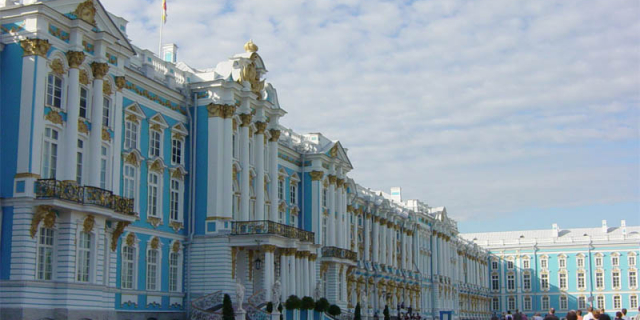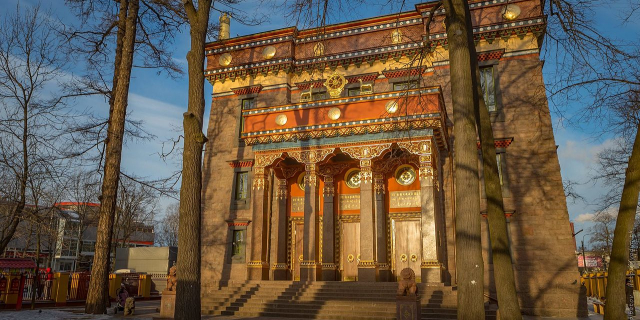Царское Село (музей-заповедник)
( Tsarskoye Selo )
Tsarskoye Selo (Russian: Ца́рское Село́, IPA: [ˈtsarskəje sʲɪˈlo] , lit. 'Tsar's Village') was the town containing a former residence of the Russian imperial family and visiting nobility, located 24 kilometers (15 mi) south from the center of Saint Petersburg. The residence now forms part of the town of Pushkin. Tsarskoye Selo forms one of the World Heritage Site Saint Petersburg and Related Groups of Monuments.
The town bore the name Tsarskoye Selo until 1918. The new Bolshevik government of Soviet Russia renamed it as Detskoye Selo (Russian: Детское Село, lit. 'Children's Village'), which it held from 1918–1937. At that time, it was renamed under Stalin's government as Pushkin (Russian: Пушкин)...Read more
Tsarskoye Selo (Russian: Ца́рское Село́, IPA: [ˈtsarskəje sʲɪˈlo] , lit. 'Tsar's Village') was the town containing a former residence of the Russian imperial family and visiting nobility, located 24 kilometers (15 mi) south from the center of Saint Petersburg. The residence now forms part of the town of Pushkin. Tsarskoye Selo forms one of the World Heritage Site Saint Petersburg and Related Groups of Monuments.
The town bore the name Tsarskoye Selo until 1918. The new Bolshevik government of Soviet Russia renamed it as Detskoye Selo (Russian: Детское Село, lit. 'Children's Village'), which it held from 1918–1937. At that time, it was renamed under Stalin's government as Pushkin (Russian: Пушкин) after the famous Russian poet and writer. It is still known by that name.
 The Alexander Palace, view of the corps de logis from the cour d'honneur
The Alexander Palace, view of the corps de logis from the cour d'honneurThe area of Tsarskoye Selo, once part of Swedish Ingria, first became a Russian royal/imperial residence in the early 18th century as an estate of the Empress-consort Catherine (later Empress-regnant as Catherine I, r. 1725–1727), for whom the Catherine Palace is named. The Alexander Palace (built from 1792 onwards) was first the home of Catherine the Great's grandson, the Grand Duke Alexander Pavlovich, who later became Emperor Alexander I (r. 1801–1825). After his abdication, Nicholas II and his family were held there by revolutionary forces under house arrest until 13 August 1917.[1] People built homes in the town where they also came to live when the court was in the country.
The Royal Forestry School, perhaps the first such school in Russia, was founded in Tsarskoye Selo in 1803. It was moved to Saint Petersburg in 1811 and developed as the Imperial Forestry Institute.[2]
According to historian Robert K. Massie,
"Tsarskoe Selo was a magnificent symbol, a supreme gesture, of the Russian autocracy. At the edge of the great St. Petersburg plain, fifteen miles south of the capital, a succession of Russian tsars and empresses had created an isolated, miniature world, as artificial and fantastic as a precisely ordered mechanical toy. Inside the park, monuments, obelisks and triumphal arches studded eight hundred acres of velvet green lawn. An artificial lake, big enough for small sailboats, could be emptied and filled like a bathtub. At one end of the lake stood a pink Turkish bath; not far off, a dazzling red-and-gold Chinese pagoda crowned an artificial hillock." The two palaces stood five hundred yards apart in the Imperial Park. "Outside the palace gates, Tsarskoe Selo, was an elegant provincial town..." The town included "The mansions of the aristocracy, lining the wide tree-shaded boulevard which led from the railway station to the gates of the Imperial Park..."[1]
Nickname for elite Soviet neighborhoodsIn the decades of the Soviet Union, people applied the nickname "the Tsar's village" to the blocks and small neighborhoods in major cities that housed the nomenklatura (Soviet elites). Their stores were better stocked, although they were still affected by Soviet-era shortages. The buildings in the neighborhoods were better designed, constructed and maintained.[3] For instance, one such neighborhood, west of Moscow, contained less industry and more parks than any other neighborhood.[4]
The stores here were better stocked, even though they were affected by the shortages. The buildings were better designed and constructed. ^ Masha Gessen, (2017). The Future Is History: How Totalitarianism Reclaimed Russia.
































Add new comment